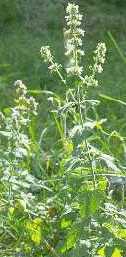

 Jump to Page Navigation buttons===>
Jump to Page Navigation buttons===>Mint, as used by Ojibwe women of the White Earth reservation in northern Minnesota, from 1907-1923, when Frances Densmore interviewed them with Mary Warren English of White Earth as interpreter and (really) co-researcher, was identified (in one or two specimens) as Monarda Mollis L, with two Ojibwe names: bibigwunukuk ("looks like a flute") and waabinowusk (" comes from the dawn, east"). I have found no pix of this species. That would be important if the mint were to be considered medically, but its medical uses were not heavy-duty: treatment of burns and boils, and a very strong tea to expel worm parasites (intestinal infestations from bad meat). Densmore identified Koellia virginiana (Mountain mint), Ojibway name Namewuskons (Little Sturgeon-fish plant) as a food plant, especially used in cooking fish, with another plant that has a fish name, Wild Ginger (Namebin) I'll treat on another page. Women used mint teas for women's medicines, too -- settlers referred to certain mints as "squaw-mint" (a pejorative way of saying the Ojibwe word ikwe meaning woman). Usually with medicines there was a mixture of several herbs, and in general root-scrapings were part of most medicines. For pleasure, and a food-value beverage, many species of wild mint were used. They had many names -- individuals often named a plant themselves, and plants were given different names according to the function being named. We are considering herbs and plants only for pleasure/nutrition, here, not medicine. Photos below show some common wild mints. They were taken by several professional photographer-herbalists for the Herb Research Foundation (associated with the American Botannical Council), and are available in larger sizes on their image database, which is slow to access and slow-loading. |
|---|
 | Monarda menthaefolia, Wild Oregano (of the Sierras). See/save a large original JPEG from the image database. This photo shows good identification characteristics for most of the mint family: the square stem, the opposed lance-shaped leaves. Crushing and smelling are good field tests. Mint species taste somewhat different. This one goes well with tomatoes raw or cooked (used a lot in southwest native cooking). It doesn't have coolness we call minty.. |
|---|
| Wild horsemint, Monardia punctata (another common name is spotted bee-balm). Big JPEG original of this photo from the Herb Research Foundation's images database. To recognize this mint by its leaves and stems when it's not in its bright yellow flower (late spring/summer), it would be a good idea to examine the Herb Research foundation's big picture. |  |
|---|
| Catnip, Nepeta cataria, is a mint family member said to be an import that went wild and now flourishes everywhere. It grows about 2' tall. The leaves are downy above and below, a little larger than peppermint leaves. By the 1890's, Ojibwe women were using it. It had a Native name, Gajugensibug, and was said to be a good tea to drink to bring down fevers, as well as pleasant-tasting. Big JPEG original of this photo from the Herb Research Foundation's images database. Mentha piperata (peppermint) and Mentha viridis (spearmint) are two other imports -- both quite good and strong-flavored -- that escaped to flourish in the wild. |  |
|---|
To use fresh mint in cooking, remove leaves from coarse stems, chop or crush. Because the flavor oil is volatile and driven off by heat, it is best to add mint -- fresh or dried -- near the end of cooking soups or stews. To make a fresh mint tea chop and crush tender stems and leaves both, use about 1/2 cup packed for 4 cups of boiling water. Don't boil the tea, pour boiling water over the leaves and steep for 5 minutes. To dry mint, remove leaves from stems; dry in shade for about 2 weeks. To make a tea, use about 1 tablespoonful of crushed, dry leaves per cup of water. Pour boiling water onto it, steep, don't boil. Mint tea does not reheat well. Mint teas can be drunk with cream or sugar or honey, but perhaps the best "tea" use of mints is to add flavor to other plant teas. To grow your own: chop a stem about 4" down from the head off clean slightly on a slant. Place sprig of mint -- found or bought -- in a small jar of clean water in a sunny window.( Almost all members of the mint family like sun.) In 2 weeks, there will be a mass of roots. It's better to root them this way than to try to dig up found plants with their old roots. Pot the mint plant and water well. To keep it bushy cut it off often from the top branches, and use it in cooking most everything, or set the cut tops aside to dry. Leaves (and stems) of all the mints can be gathered any time during the summer; some feel the flavor is strongest when the plant is not in flower. Fresh young spring shoots from the perennial roots can be cooked and served with butter and salt. Mint leaves and tender springs can be mixed with any fresh salad greens, and are used a lot in Middle Eastern cooking. |
|---|

Custom Search
|
CREDITS: Photos from Herb Foundation's image database. Two were taken by Mimi Kamp The horsemint/bee balm photographer wasn't identified, but has identified himself recently: Michael Moore.
Last Updated: Wednesday, December 27, 1995 - 7:32:35 AM